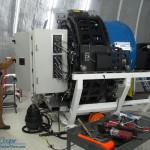W. M. Keck Observatory press release…
Engineers and astronomers are celebrating the much anticipated first light and first two nights commissioning of the MOSFIRE instrument, now installed on the Keck I telescope at W. M. Keck Observatory. MOSFIRE (Multi-Object Spectrometer For Infra-Red Exploration) will vastly increase the data gathering power of what is already the world’s most productive ground-based observatory.
“This is a near-infrared multi-object spectrograph, similar to our popular LRIS and DEIMOS instruments, only at longer wavelengths,” explained Keck Observatory Observing Support Manager Bob Goodrich. “The dedicated MOSFIRE project team members at Keck Observatory, Caltech, UCLA, and UC Santa Cruz are to be congratulated, as are the dedicated observatory operations staff who worked hard to get MOSFIRE integrated into the Keck I telescope and infrastructure. A lot of people have put in long hours getting ready for this momentous First Light.”

First light with MOSFIRE, and unprocessed image of the interacting galaxies NGC4038 and NGC4039, credit: W. M. Keck Observatory
The first unprocessed image from MOSFIRE was made on the night of April 4, despite thick cirrus clouds over Mauna Kea. The subject was two interacting galaxies known as The Antennae. Additional images adn spectra were gathered on the night of April 5, as part of the continuing commissioning of the instrument.
MOSFIRE gathers spectra, which contain chemical signatures in the light of everything from stars to galaxies, at near-infrared wavelengths (that is, 0.97-2.45 microns, or millionths of a meter). Infrared is light which is beyond red in a rainbow—just beyond what human eyes can detect. Observing in the infrared allows researchers to penetrate cosmic dust clouds and see objects that are otherwise invisible, like the stars circling the supermassive black hole at the center of the Milky Way. It also allows for the study of the most distant objects, the light of which has been stretched beyond the red end of the spectrum by the expansion of the universe.
Astronomers plan to use MOSFIRE to study the time when most galaxies formed, as well as the so-called period of re-ionization, when the universe was just a half-billion to a billion years old. Other targets will be nearby stars, young stars and even brown dwarfs, which are stars not quite massive enough for nuclear fusion to ignite in their cores.
What sets MOSFIRE apart from other instruments is its vastly more light-sensitive camera and its ability to survey up to 46 objects at a time, then switch targets in just minutes. That’s an operation that takes comparable infrared instruments one to two days.

Mark Kassis stands beside the MOSFIRE spectrograph
MOSFIRE can also scan the sky with a 6.1 arc minute field of view, which is about 20 percent of a full moon and almost a hundred times more sky than the Keck’s current near-infrared camera. To take spectra of multiple objects, the state-of-the-art spectrometer consists of 46 pairs of sliding bars that open and close like curtains. Aligned in rows, each pair of bars blocks the sky, leaving a small slits between the bars which allow slivers of light from multiple targeted objects to leak through. Light from each slit then enters the spectrometer, which breaks down the objects’ light into their spectrum of wavelengths.
Because everything that’s even a little warm radiates infrared light, all infrared instruments must be kept very to prevent any trace of heat from the ground, the telescope, or the instrument itself from messing up the infrared signals from space, MOSFIRE is kept at a cool 120 Kelvins (about -243 degrees Fahrenheit or -153 degrees Celsius). Because of this, MOSFIRE is the largest cryogenic instrument on either of the Keck telescopes.
“We look forward to the rest of MOSFIRE commissioning, and the start of science operations,” said Goodrich.
UCLA’s Ian McLean and Caltech’s Keith Matthews, who have built other Keck instruments, played leading roles. The team includes the engineering and technical staff of Keck Observatory, the technical staff of the UCLA Infrared Lab, optical designer Harland Epps of UC Santa Cruz and the staff of Caltech Optical Observatories. The spectrometer was made possible through funding provided by the National Science Foundation and a generous donation from astronomy benefactors Gordon and Betty Moore.

